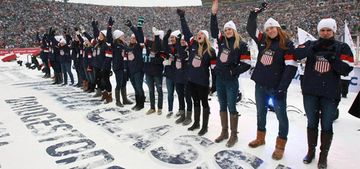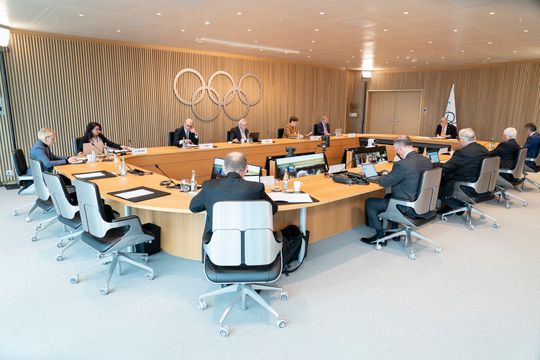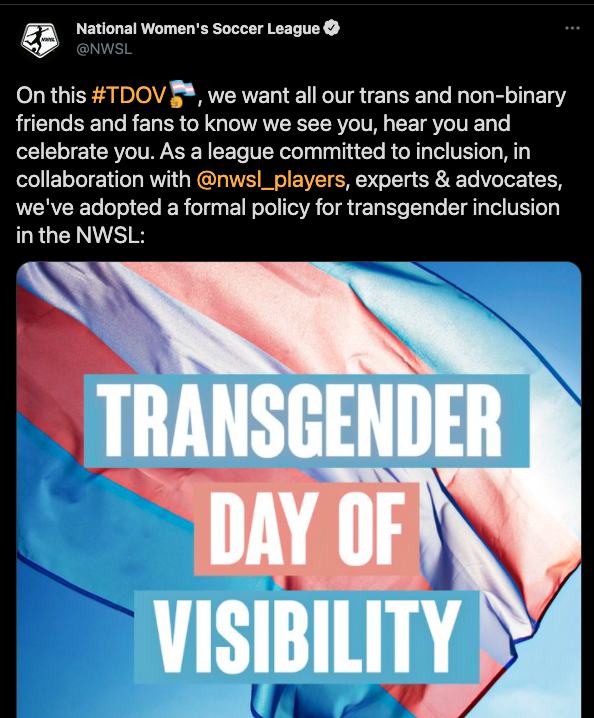Professional sports is an entertainment product, and as a result, every sporting league that hopes to be profitable has to be conscious of exactly what they are selling. It's important that the product be entertaining, and it's easy to sell violent theater -- the NHL and pro hockey have excelled at this paradigm by regulating and celebrating fighting, rather than banishing it from the game. It's also important that the game be considered "fair." If it weren't "fair", would people buy tickets to see it? Would people place bets on it? Would people tune in to watch it on television? Few sports fans want to participate in a rigged game. However, pro sports leagues are rarely confronted with challenges to their concept of "fairness" -- to the fact that the game they built was designed to benefit a select few.
When trans, nonbinary, or genderqueer athletes are excluded from sports, this exclusion usually takes place in the name of "fairness". The decision-making process surrounding who gets to play against whom is usually determined by cis men and cis women. The rules that trans athletes have to follow are determined by cis men and cis women. Consequently, the sporting lives of trans, nonbinary, and genderqueer athletes are controlled by cis people for the advantage of cis people. At the heart of this control is a desire to not only maintain the sports landscape as cis, but to ensure that a disproportionate and undeserved amount of financial resources, facilities and equipment, coaching expertise, and media attention are lavished on cis men's sports.
A major factor in this discrimination is the toxic attitudes and alarmism in Canada and the United States towards gender-diverse athletes, because of hormone therapies that are available for trans people and, more generally, testosterone. The "othering" of trans people because of this discriminatory biological essentialism permits people to continue to elevate cis men's professional sports above all others.
Cis men occupy an unjust amount of space in the sports landscape, and cis men often pivot to biology to explain this monopolizing, instead of confronting its causes, which are steeped in racism, sexism, homophobia, and transphobia. This biological defense makes the central argument that cis men are taller, stronger, faster, more competitive – in short, that they're superior physical specimens. As a result, the claim is that they are simply better at sports than cis women. When pushed further, the biological supremacy defense rests on cis men's production of the hormone testosterone as the reason that cis men athletes excel at their sport.
Testosterone, the most well-known androgen, is associated with increased muscle mass, bone density, and secondary sex characteristics, such as beard growth; physical components that are often culturally associated with strength and masculinity, despite the fact that both cis men and cis women produce the hormone at varying levels. For those who believe in the inherent supremacy of cis men as athletes, it's not that there are longstanding institutional biases against all other athletes, but that cis men are simply predisposed to be physically better at sports. The biological supremacy defense rests on the belief that cis men's bodies are physically exceptional and that testosterone levels are both a definitive and quantifiable measure of this exceptionality.
When the inclusion of trans athletes is publicly debated (a debate that largely focuses on trans women), cis gatekeepers weaponize testosterone levels. Of course, there are still many cis people who point out that amab folks, whether they are trans, nb, or genderqueer, or have physical advantages such as height, which can't be changed regardless of hormone treatments. However, one need only point out the presence of tall women athletes in a variety of sports to refute such an argument.
The hormone argument can be effectively deployed by cis gatekeepers; it can both be quantified by measurable levels and has a symbolic impact. It is also poorly understood by the majority of people who are unfamiliar with the scientific literature regarding testosterone. The hormone takes on an almost mythical quality. Testosterone is not just associated with increased muscle mass, but also with cis men's sexual arousal and expression, as well as their "natural" aggressive tendencies. In short, testosterone is associated with the hyper-masculinity of men's sporting cultures, which relish violence and are typified by toxicity. Sports that choose to codify violence as an essential component of the game, such as men's hockey, do so because such physical displays are assumed to be indicative of both masculinity and the superiority of cis men's bodies. Hockey serves as a useful example in the T debate, because much of what T is credited with doing isn't actually essential to the game, as the rules of the women's game makes clear. A cis gatekeeper might argue that elevating testosterone levels should always and obviously be associated with superior athletic performance.
Unfortunately for bigots, proving a certain athletic advantage is much more difficult. Individual sports differ from one another in terms of their rules and gameplay. Some account for physical differences with distinctions like weight classes, while others do not. The physical attributes most associated with weightlifting excellence, for example, are not the same as those required for short-track speedskating dominance. Athletes who participate in sports that emphasize quickness, agility, and flexibility don't necessarily benefit from increased muscle mass. Determining what is an unfair advantage becomes even more difficult in the case of athletes who participate in team sports. There is no consensus about what constitutes an unfair advantage; but as sports communities, we still believe that gender-diverse athletes do possess one.
Earlier this year, a group of British researchers and medical experts undertook a comprehensive literature review of academic studies that examined testosterone's impact on athletic ability and possible advantages that trans athletes might have when playing competitive sports. What they found was a lack of agreement on what constituted athletic advantage, a dearth of empirical research on how testosterone levels predict athletic performance, and no large-scale and long-term studies on trans athletic performance both prior to and during HRT use. The academic studies they surveyed revealed that "testosterone is only one part of a person's physiology and there are other important factors (both biological and environmental) that should be considered if fairness (the absence of advantage) is the aim in competitive sport". According to the team's report, what little research has been done about testosterone and athletic advantage indicates that "there is no evidence to suggest that endogenous testosterone levels are predictive of athletic performance (apart from doping), as there is variation in how bodies make and respond to the hormone." This suggests that our understanding of testosterone advantage isn't based in scientific evidence, but is instead linked to our understanding of PED use. Given this paucity of information, the team concluded that "There is no direct and consistent research to suggest that transgender female individuals (and transgender male individuals) have an athletic advantage in sport and, therefore, the majority of competitive sport policies are discriminatory against this population".
Further cementing the popularity of the hormone debate is testosterone's relationship to performance-enhancing drugs. Anabolic-androgenic steroids, more popularly known as anabolic steroids, increase protein in cells and stimulate secondary sex characteristics that are typically associated with cis men. Testosterone is a natural anabolic steroid. Athletes can take testosterone injections as a performance enhancer to build muscle and recover faster; more typically, synthetic modifications of testosterone are taken. A variety of synthetic steroids exist with a dual purpose of performance enhancement and concealment of use. This differentiates doping infractions from HRT; PED use is meant to deceive, whereas for many, HRT is medically necessary.
The use of performance-enhancing drugs is not new. This type of performance enhancement is not limited to one nation, despite attempts to historically pin doping on Soviet and Eastern Bloc countries and the recent controversies engulfing various Russian sports agencies. The United States Olympic Committee's reputation has been repeatedly tarnished by doping allegations, positives tests, and stripped medals; all countries have athletes who use PEDs at various levels of competition. This type of performance enhancement is not limited to specific sports, as baseball, cycling, skiing, and track and field have all been subject to numerous doping scandals. Sports which have not yet been embroiled in such controversies have likely avoided them because of lack of scrutiny and lax testing policies, rather than some sort of underlying morality in players of a particular sport. In other words, hormonal doping infractions are a ubiquitous part of the cis sports world, and the cis sports world selectively chooses when and if they care about it. Some sports (like hockey) and governing bodies (such as the NHL) almost definitely have undetected PED users in their ranks, rather than purely clean athletes.
Since the impact of testosterone is understood by most sports fans in the context of PED controversies, is it any wonder that trans athletes, especially trans women athletes, are unfairly targeted and discriminated against? Using performance-enhancing drugs in sports is about deception, and the cis world still views gender-diverse folks through that same lens. Sporting bodies, such as the IOC, NCAA, and NWHL, that have attempted some degree of trans inclusion, have strict policies regarding the hormone levels of trans athletes. Trans women must take hormone therapy for at least one year, according to IOC guidelines, to suppress testosterone levels if they wish to participate in women's sports. The study I cited earlier (Jones et al.) stressed that these guidelines "are not underpinned by evidence-based medicine" and that the length of time during which trans athletes must undergo HRT before being eligible to compete similarly lacks a sufficient rationale, but noted that these mandatory periods are similar in length to bans athletes receive for doping infractions. In other words, mandated trans compliance is viewed in the same vein as a punishment for cheating.
Many who support and advocate for the inclusion of trans women in women's sports stress that while undertaking hormone therapy, trans women do not have an unfair physical advantage when compared to cis women. For me, this argument both misses the point and relies on the biological supremacy argument that is so effectively used by cis men to maintain their unfair power and privilege in sports. It subjects trans bodies (in this case, trans women's bodies) to cis understandings and regulations, which are often conceived with little input from the gender-diverse community and even less evidence-based research. These guidelines, then, are developed with the core idea that a trans person intends to deceive the sports world.
Trans women should be able to compete in women's sports because they are women. Trans women should be able to make transition-related decisions about their physical appearance, health, and well-being on the basis of their desires and needs, not to achieve compliance with arbitrary cis regulations. Much of the opposition to amab folks participating in women's sports is driven by the erroneous and bigoted view that amab gender-diverse folks, especially trans women, are men wishing to participate in women's sports as a method of cheating. However, regulations about hormone levels stem from the same faulty premise as those views: that through hormone testing, an essential womanhood can be defined, and acceptable (lesser) women's bodies can be achieved that are distinct from those of cis men.
We know that such thinking leads to discrimination; we have seen it play out against women with hyperandrogenism or athletes with intersex conditions. These regulations are frequently hailed as inclusive when in reality, they carefully limit the number of gender-diverse people who can participate in sport and safeguard the cis and binary nature of organized sports. When sporting bodies determine that hormone therapy is a requirement for amab trans, nonbinary, and genderqueer participation in sports, it limits participation for amab gender-diverse folks. The sports world is at the forefront of the debate over the validity of trans, nonbinary, and genderqueer lives. Existing inclusive legislation in sports still seeks to limit trans bodies in public space, and that is a problem.
The biological supremacy argument, which places such value on the importance of testosterone in athletic performance, actively harms afab gender diverse athletes as well. Those who argue for the inclusion of amab gender diverse people in women's sports if they undergo hormone therapy use the limiting and binary understanding of the differences between men's and women's bodies that serve to cement cis men's undeserved sporting primacy. What follows from this argument is a paradoxical understanding of afab gender diverse athletes.
Consequently, sporting bodies do not develop specific policies regulating the hormone levels of afab athletes participating in men's sports, because of two key assumptions. First, they assume that afab bodies are inherently lesser than those of cis men, and are therefore irrelevant in terms of issues of fairness or performance at the highest levels. This argument relies on the sexism inherent in the binary division of sport, the purpose of which is to privilege cis men. Second, "inclusive" sporting bodies don't regulate the hormone levels of afab athletes participating in men's sports because testosterone levels are only considered to be an advantage when competing against women; the wide variation in testosterone levels among cis men is irrelevant because it is deemed to be "natural." Ignoring afab trans, nonbinary, and genderqueer athletes in inclusion policies does afab gender-diverse athletes a disservice because men's sports, and especially men's team sports, are not required to adapt and become more inclusive.
By not considering trans men athletes, cis men's sports leagues remain hostile to and limit the sporting opportunities of trans masculine folks. It maintains a situation in which trans masculine athletes are ostracized from cis men's team sports. However, if afab gender diverse athletes wish to play women's sports, they cannot undergo hormone therapy. These regulations understand HRT as a method of limiting and lessening the talents of amab gender-diverse athletes while enhancing afab gender-diverse athletes and ignore the humanity of trans, nonbinary, and genderqueer athletes.
Again, this understanding is based on the belief that testosterone level is the greatest factor that impacts fair play. Emphasizing biological differences allows those in positions of power in sport; typically men who are also cis, white, straight, and rich, to continue to manipulate sports to suit the needs of cis men.
When we acknowledge fair play as an argument for equality in sports, different understandings of "performance enhancement" emerge.
One of the greatest factors impacting athletic performance is not biology, but economic status. Kids who grow up rich get access to better equipment, fields, and coaching, and can afford to spend significant time on honing their crafts. The professionalization of sport is an inherently capitalist venture, and while various pro sports like hockey and football have community outreach programs that are designed to bring the game to financially disadvantaged kids, there is minimal interest in leveling this particular playing field.
Those who mistakenly believe in the supremacy of men's sports usually rely on the subjective argument that men athletes are simply "better". However, to make such an argument, supporters have to deliberately ignore a lengthy history of discrimination on the part of cis men to limit and curtail the access to sport that people of other genders have had. There are numerous examples of women being barred from participating in sport, or even simply banned from attending sporting events. Decades after programs designed to foster equality in sport, there can still be considerable discrepancies in terms of resources between boys and girls sports development in many sports like soccer, baseball, and hockey. Disproportionately allocating sports resources to cis boys and men actively hampers the development of athletes of other genders.
Cis men have created the rules for many of the games we play, and often did so in ways designed to emphasize the ways testosterone is associated with toxic masculinity. Despite mounting evidence that sports violence is an unnecessary and extremely hazardous component of games like hockey, cis men fans, athletes, and the sporting bodies that govern men's sports defend violent on-ice displays, such as dangerous hits and fighting because it cements conventional understandings of hockey as a "man's game." But hockey doesn't need fighting and it doesn't need hitting. Women's hockey provides an example of how the game can be played without those elements. When cis men make harmful arguments in favour of protecting and enshrining various forms of physical violence in the sports they watch and play, they do so in part so that no one else can play. They do so to ensure that no one else can challenge the undeserved resource, financial, and media drain that is cis men's sports.
There are advantages in sports, but trans, nonbinary, and genderqueer athletes are not the beneficiaries of these advantages. There are high-profile trans athletes willing to work within the restrictions placed on them by cis sports officials. They might accept and agree with these regulations, but one thing is sure: they have no option but to comply if they wish to continue their athletic careers. These restrictions are all the more punitive because they are not based in empirical evidence, but in the fear, hatred, and greed of the cis sports community. Pro sports leagues care more about preserving their own space than about fairness. The game is always going to be rigged.
(Photo credit: National Library of Ireland/Flickr Commons, no known copyright restrictions)







